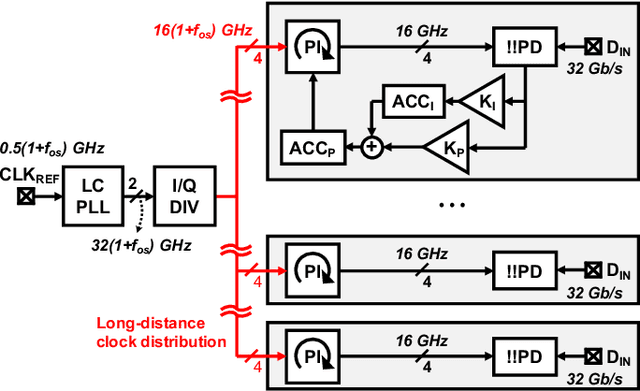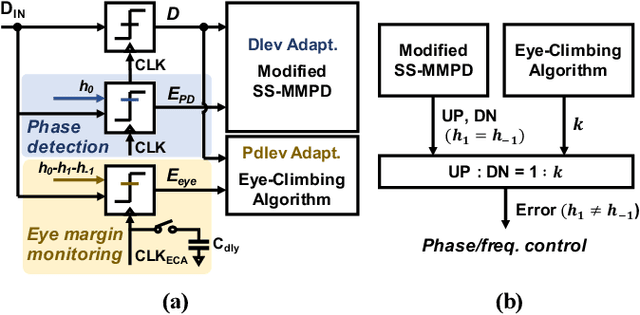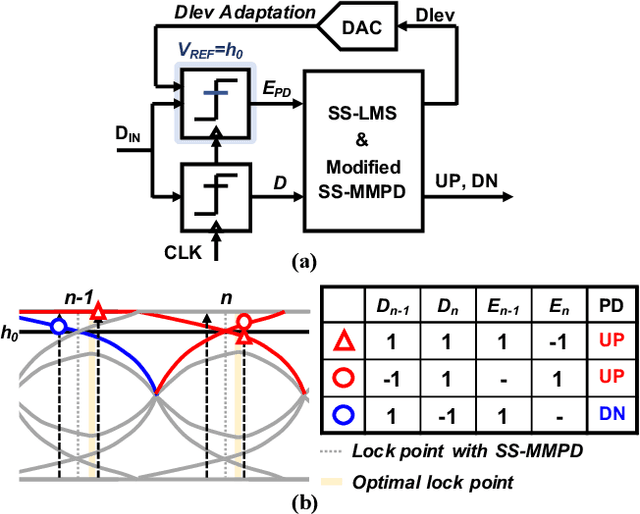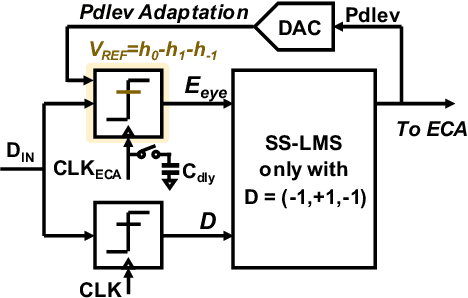Haengbeom Shin
A 4x32Gb/s 1.8pJ/bit Collaborative Baud-Rate CDR with Background Eye-Climbing Algorithm and Low-Power Global Clock Distribution
Apr 10, 2024



Abstract:This paper presents design techniques for an energy-efficient multi-lane receiver (RX) with baud-rate clock and data recovery (CDR), which is essential for high-throughput low-latency communication in high-performance computing systems. The proposed low-power global clock distribution not only significantly reduces power consumption across multi-lane RXs but is capable of compensating for the frequency offset without any phase interpolators. To this end, a fractional divider controlled by CDR is placed close to the global phase locked loop. Moreover, in order to address the sub-optimal lock point of conventional baud-rate phase detectors, the proposed CDR employs a background eye-climbing algorithm, which optimizes the sampling phase and maximizes the vertical eye margin (VEM). Fabricated in a 28nm CMOS process, the proposed 4x32Gb/s RX shows a low integrated fractional spur of -40.4dBc at a 2500ppm frequency offset. Furthermore, it improves bit-error-rate performance by increasing the VEM by 17%. The entire RX achieves the energy efficiency of 1.8pJ/bit with the aggregate data rate of 128Gb/s.
A 0.65-pJ/bit 3.6-TB/s/mm I/O Interface with XTalk Minimizing Affine Signaling for Next-Generation HBM with High Interconnect Density
Apr 08, 2024



Abstract:This paper presents an I/O interface with Xtalk Minimizing Affine Signaling (XMAS), which is designed to support high-speed data transmission in die-to-die communication over silicon interposers or similar high-density interconnects susceptible to crosstalk. The operating principles of XMAS are elucidated through rigorous analyses, and its advantages over existing signaling are validated through numerical experiments. XMAS not only demonstrates exceptional crosstalk removing capabilities but also exhibits robustness against noise, especially simultaneous switching noise. Fabricated in a 28-nm CMOS process, the prototype XMAS transceiver achieves an edge density of 3.6TB/s/mm and an energy efficiency of 0.65pJ/b. Compared to the single-ended signaling, the crosstalk-induced peak-to-peak jitter of the received eye with XMAS is reduced by 75% at 10GS/s/pin data rate, and the horizontal eye opening extends to 0.2UI at a bit error rate < 10$^{-12}$.
 Add to Chrome
Add to Chrome Add to Firefox
Add to Firefox Add to Edge
Add to Edge